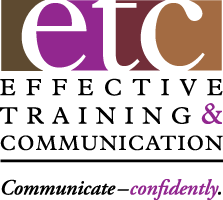Creating Audience-Centered Presentations can be a key to your career success in the job you have … or the job you want. And adding some new, different or better tools to your Workplace Presenter Tool Kits is simple … but not necessarily easy.
So … let’s briefly discuss seven Best Practices for creating Audience-Centered Presentations that engage and get results. When you apply them, you’ll create better, shorter, more focused and results-driven workplace presentations in less time. For the sake of brevity, we’ll limit our focus today to creating the message and leave physical and vocal delivery skills for a follow-up piece.
1.Embrace Audience-Centricity & the ‘Platinum Rule’. Far too many workplace presenters are subtly guided by the ‘Golden Rule’. They create and deliver presentations they way they would like other people to present to them. Not very audience centered … or successful.
So, with the ‘Platinum Rule’, first developed by Dr. Tony Alessandra over 25 years ago, you present to others the way they want you to present to them. It’s 10 times harder but 100 times better. You give the audience only the information they need and what in the amount they need and want to accomplish the objectives that brought them in front of you.
2. Define audience outcomes up front. Answer the obvious questions your audience has very quickly in your introduction, such as ‘Why am I here?’ and ‘What will we talk about?’ Tell them what they can expect to know, be able to do or believe after the presentation that they didn’t know, could do or believed before it. Also mention the ‘WII-FM’ value proposition of your content – ‘What’s In It For Me?’
3. Engage audience throughout. You can engage audience participation right from the start by inviting their questions anytime and all the time and even asking them several ‘show of hands’ questions. Depending on content, you can ask them to briefly discuss a specific topic or issue with the person next to them or in triads. The over-arching goal is that your audience-centered presentation look as little like a lecture as possible.
4. Start Strong with a Power Intro
The introduction is often the most important part of your message. It sets expectations, establishes tone and style and projects your competency and confidence. That’s a lot of work to do in 10% or less of your total presentation time. Properly done, you can ‘Get them at Hello!’ by:
- Capturing audience attention immediately with a thought-provoking question, relevant quote, impressive statistic or very short example.
- Defining presentation objectives and outcomes. Stress the value proposition of the content & ‘WII-FM’ as previously noted.
- Overviewing key content points.
- Mentioning process details – handouts, when to ask questions, etc.
- Transitioning smoothly to your first point or sub-topic.
5. End Strong with a Power Close
How you end your presentation is also important. It’s what the audience will remember most. An effective Summary or Conclusion should be less than 5% of your total time, not introduce new information and not be the Q&A session. Instead:
- Briefly summarize key content and its value proposition.
- Deliver a ‘Call to Action’ – tell them what they should do now or next?
- Consider restating your opening attention-getter so you bring them full circle.
6. Allow Content to Rule
Content still rules – it always has. Share enough of the right kind of information and structured in the right way that is appropriate for your specific audience to accomplish your objectives and provide value for them. Consider supporting your points with facts, statistics, quotes, brief examples, etc. Connect the dots for them and remember to ‘KISS Your Audience’ – ‘Keep it Short & Simple’.
7. Avoid ‘Death by PowerPoint’
A painful slide show is no way to engage an audience. Make sure each slide accomplishes a specific purpose for message and audience. Use slides because you should, not because you can. Remember that Less is More, Bigger is Better and Pictures beat Text.
As you’ve seen, Creating Audience-Centered Presentations can engage your audience better, achieve better results, project a more professional image and enhance your career growth. Best wishes for success as you earn your spot on the Varsity Presenters’ Team.
